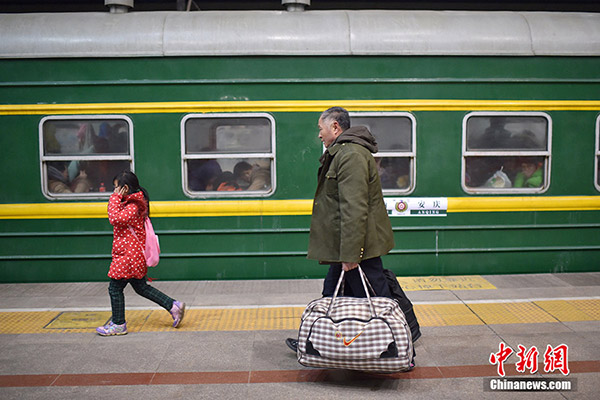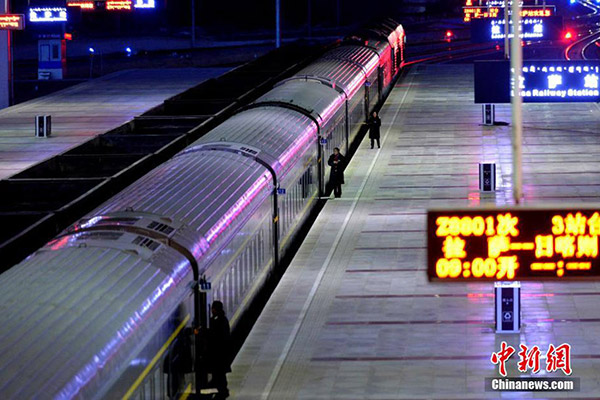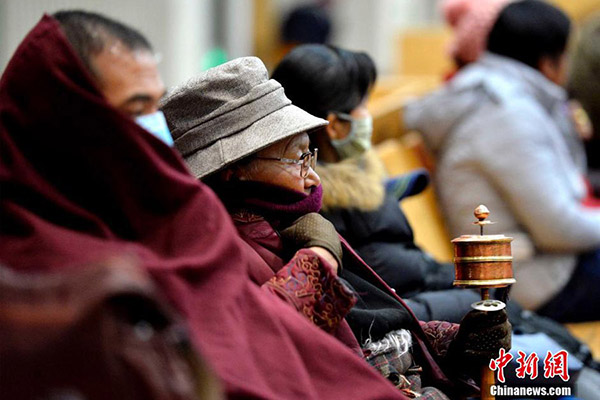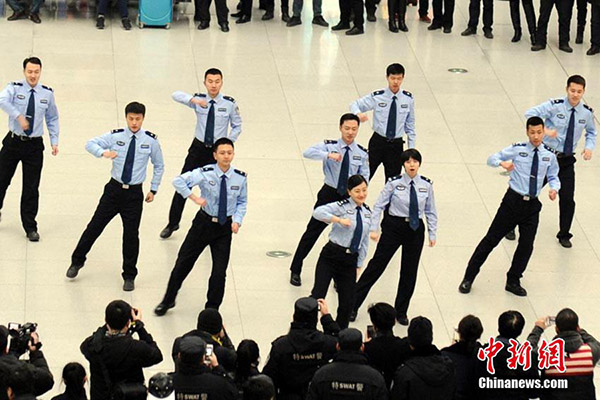
Passengers walk to board an extra train bound to Anqing city, East China’s Anhui province, at Beijing West Railway Station on Jan 24, 2016. The train marks the start of travel rush of the 40-day Spring Festival travel. [Photo/Chinanews.com]
BEIJING — High-speed trains with comfort, Starbucks coffee onboard, free WIFI in stations, and phone apps for ticket purchase. As the Spring Festival travel rush kicked off on Jan 24, hundreds of millions of Chinese found that their journeys for holiday homecomings have become much smoother and faster.
This year’s Spring Festival travel rush reflected how China’s economic boom, huge investment in infrastructure and fast growth of information technologies totally redefined the once gruelling experience of going home for the Chinese New Year, which falls on February 8 this year.
Jan 24 marks the beginning of the annual Spring Festival travel around China with the first train at each station carrying the festival passengers. The total passenger traffic volume at all railway stations is estimated to reach more than 2.91 billion during the 40-day Spring Festival Travel from Jan 24 to March 3, said the Ministry of Transport.

Passengers take photos when No 3806 train, from Guangzhou east railway station to Chongqing north railway station, pulls out of the Guangzhou east railway station in Guangzhou city, South China’s Guangdong province, at 0:26 am, Jan 24, 2016.[Photo/Chinanews.com]
MODERNIZED JOURNEY
At Shanghai Railway Station, the ticket office is no longer crowded. In previous years’ travel rush, the ticket office was crammed every night with tens of thousands of people who had to line up for the whole night to buy a ticket.
But this year, about 83 percent of tickets were purchased online.
China’s railway service has been adapting to hi-tech trends by making itself accessible through websites and mobile phone apps, said Zhu Wenzhong, passenger traffic director of Shanghai Railway Bureau. Passengers now could order onboard meals on the phone app before boarding. Drinks made by Starbucks are available on certain trains.
Across China, free WIFI is offered in some train stations and electronic ticketing machines were placed in bus stations. An online system that integrates bus operators in 13 provinces has been launched.
The Ministry of Transport said this year it started to use big data to analyze the Spring Festival traffic.
Chinese car-hailing app Didi rolled out a car-pooling service that can pair travelling needs across the country, making it possible for drivers to take on others when travelling home for the Chinese Lunar New Year.
Train stations have also been modernized. In the city of Nanchang, a railway hub in east China, passengers used to wait outside Nanchang Railway Station as there was not enough room indoors during the Spring Festival travel rush. But this year, they can wait inside the station as a high-speed train station was just added to the city.
FASTER RIDE
This year, Gong Xinyi, a college student in Shanghai, traveled back to her hometown in Jiangxi province with only one third of the time that she used to spend.
A newly added high-speed route has linked Gong’s hometown with Shanghai and shortened her journey to three hours. Last year, she had to take a 7-hour-train ride and an additional 3-hour bus trip.
Gong’s faster Spring Festival journey is made possible as China has been investing heavily to expand its high-speed train network which is already the world’s largest.
Of all the trains serving in the Spring Festival travel rush this year, more than 60 percent are high-speed trains that can run up to 350 kilometers per hour.
Around 3,300 kilometers of new lines were added to the high-speed railway network last year, bringing the total length to 19,000 kilometers, which make up 60 percent of the world’s total.
From 2011 to 2015, the period in which China’s 12th Five-Year Plan was implemented, fixed-asset investment in railways amounted to 3.58 trillion yuan ($544 billion), up 47.3 percent from the 11th five-year-plan period.
Sheng Guangzu, general manager of the China Railway Corp., said China plans to invest 800 billion yuan in railways in 2016, especially in less-developed central and western regions.
High-speed rail service continues to carry more weight in the Spring Festival travel rush because more Chinese now can afford to travel in style after the country’s average disposable income surged by more than seven percent every year over the last decade.
Chinese people’s growing ability to afford a faster journey has also fueled an air travel boom.
Chinese airlines are expected to carry 54.55 million passengers in the Spring Festival travel rush, up 11 percent from the last year.
Air China said during the Spring Festival travel rush, it would add 2,432 flights and operate an average of 1,160 flights daily.
China Southern Airlines planned to add over 6,000 flights on 155 international and domestic routes during the Spring Festival travel rush.
Effort has also been made to ensure a faster trip back on the ground. As no toll way fee is charged nationwide during the seven-day Spring Festival holiday, traffic jams on highways had trapped thousands of cars for hours in previous years.
Zheng Zongjie, an engineer at the road network center of the Ministry of Transport, said this year car drivers would no longer need to pick up the tickets at toll gates to make traffic smoother, as they did during previous free-hours.
Urban transportation would also be improved with better arrangement of metro, bus and taxi in the Spring Festival travel rush, the authorities said.

Train number Z8801, from Lhasa to Shigatse in Southwest China’s Tibet autonomous region, at Lhasa railway station, Jan 24, 2016. The train marks the beginning of the region’s Spring Festival travel. [Photo/Chinanews.com]

Passengers sit in the waiting room at Lhasa railway station in Southwest China’s Tibet autonomous region, Jan 24, 2016. [Photo/Chinanews.com]

Passengers swipe their tickets to enter the Taiyuan railway station in North China’s Shanxi province, Jan 24, 2016.[Photo/Chinanews.com]

Railway policemen perform at the waiting room of Changchun railway station in Northeast China’s Jilin province on Jan 24, 2016. The dance is aimed at making passengers happy.[Photo/Chinanews.com]
